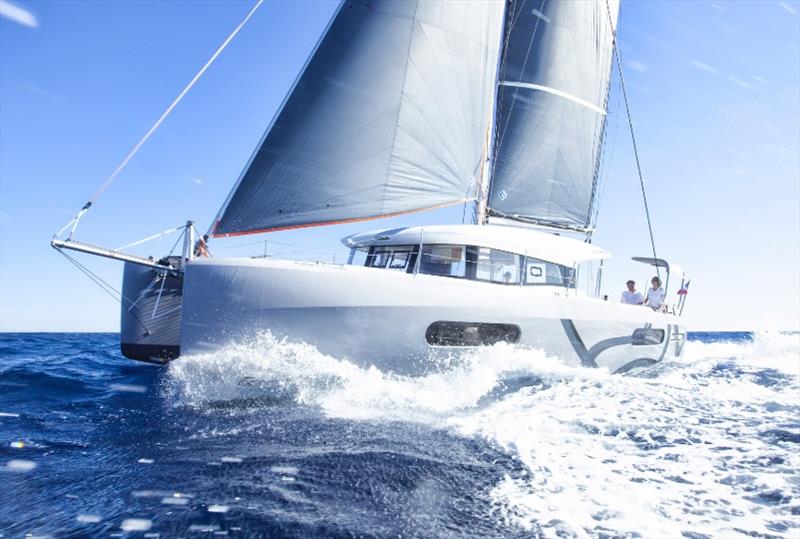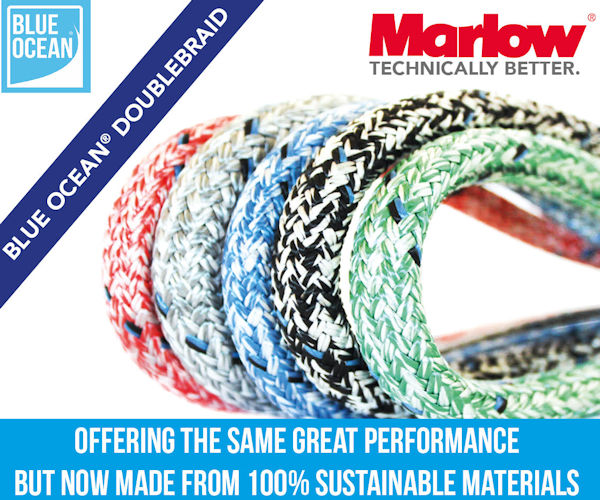
Excess 12 - photo © Excess Catamarans
Dear Recipient Name
Indeed, I was pretty aware of the adage, 'If only the young knew, and if only the old could.' Now today, whilst not over the hill by any means, I have a different appreciation for the words, and there are a lot of things behind the Groupe Beneteau brand, Excess, that resonate. Chiefly there was a bit of irony behind the name, and who doesn't like a giggle?
Of course there was nothing funny about the powerhouse Groupe creating another cat brand, but the notions of starting with a monohull, then splitting it and putting a platform in the middle, and not aim for a hull out and 20+ knots SOG, but to kill the Diesels quickly, had heaps of merit. Alas, here was a sailing cat, not a motor/sailer, and one that could put a smile on your dial whilst under way, and on all of your family and guests when at anchor. Gotcha...
To that end, I spoke at length with the father of Excess, Bruno Belmont, and chief of her commercial success, Thibaut de Montvalon, now that they are just over one year old in the public's eye.
"We sold a little over 60 boats in our first year, mostly Excess 12s (see the video), but also 11 and 15, and delivered nearly 40 so far." Sail area to Displacement (efficiency) has always been a key element of the Excess mix. The Excess is 5% better in standard form, and 10% with the taller Pulse Line rig, than her competitors. Interestingly, 95% of orders to date are choosing Pulse Line option, so why is this not standard? Equally, if the whole brand is predicated on the idea to sail faster, more often, for better cruising, and less diesel, then why is this not the USP?
"We paid an expensive price when launching Excess in September 2019 with an 'all inclusive' product: the sticker price was too high, and despite the communication made in Dusseldorf 2019, very few media explained this 'all inclusive' strategy, forcing us to get back to a more conventional offer."
"Although a lot of the early orders were Pulse Line due to dealers stocking boats to promote the brand locally, we believe that in the long run Pulse Line could be around 50% of our sales. And since we also see some charter companies being interested in Excess concept, we know they will not want to upgrade to the Pulse Line."
Dorothy Dicks
So then, does having Excess in charter fleets cannibalize Lagoon? Does it dilute Excess? "Charter sales are a necessity for any mass producer boatyard, and Excess will not rule them out. But there are three types of sales made today:
- A private customer that has a private use program: sabbatical journey, live aboard, round the world, retirement home, occasional vacation, etc. We believe that Excess will address these customers, especially the ones coming from the monohull world.
- A private customer that must run his boat under management to cover up part of the expense. We believe that some Excess owners will need this management system.
- We have the feeling that some charter companies willing to offer a different opportunity to the generalists will be interested in Excess. Additionally, the price positioning of the Excess 11 makes it attractive even for generalist charter fleets."
"To say that there will be no porosity between Lagoon and Excess would be a mistake, but we believe that there are more common points between an Excess and a Nautitech for instance, than between an Excess and a Lagoon, which will be more often compared to a Fountaine Pajot. Time will tell the percentage of porosity. We hope that our brand's positioning will help to minimize it!"
Just on that, and apart from what you read in this particular missive, these quintessential elements form the cornerstone of Excess, and the perception thereof:
- Designed by and made for sailors for the love of sailing - "YES, as much as anchoring: BALANCE!"
- Comfort, space and volume of the cruising cat, but feel of something more exciting - "YES, no trade in expected comfort of a cat: bed size, fridge volume, etc AND exciting sailing sensations: BALANCE!"
| |

|
|

|
| |
- Offer sailing sensations to people looking for something different. The aft steering position for vision and direct connection, driving on top of rudder - "YES, and be part of the cockpit, invite guests to come and steer, share the pleasure of feeling the rudders, helming with great vision to the sea."
- Visibility across the boat and see through it all, so sit low and see out below the jib - "YES!"
- I used to own 45 to 50 foot mono, and now want to cruise farther, with more living comfort, but not loose my sailing pleasure - "YES; a boat that satisfies an ex-monohull sailor, and also gets the support of all the rest of the family."
- So it is experienced crusaders who have crossed the Atlantic, but now want to go even farther - "The owner's profile could be this, or slightly younger sailors looking for a beautiful boat for next door trips, or even a little younger families going for a sabbatical experience. And as said before, there will also be some boats in charter fleets willing to offer a different catamaran experience."
- Super low boom for access and looks - "YES, and sailing efficiency (plate effect for better performance and pointing)"
So just who went to market?
So if in 2008 the monohull market divided by four, and today it's only back to half of that, it is not so much the fault of the monohulls, but the power of the cruising cat. Excess is a clear strategy from Groupe Beneteau, when monos were their bread and butter, but can monos hang on, or is it all one-way traffic from here?
"The fantastic growth of multihulls between 2000 and 2020 will eventually calm down. The COVID-19 crisis could have been the event that rings the bell to a flatter market, but it is not what we see in private sales. Overall what we see is a continuous growing trend in favour of multihulls, even if we do not expect the same rate as what we have seen between 2015 and 2020. It will keep growing, but at a slower and more consistent pace."
"The monohull market has certainly suffered over the last ten years, but within this flat to declining market, Groupe Beneteau gained market share due to trouble in the major competitors who were very dependant on charter investors. Our vision is that there is a future for the monohull in the long run, through innovative approaches."
Of course 2020 has been one of incredible paradigm shifts, so if the premise for the brand was predominantly private, ex-monohull owners, and to be half the size of sister brand Lagoon in say three years (and by default #2 globally), then 200-300 units per annum was the pre-COVID estimation. A second lockdown cannot be helpful. So what is the expectation now? "We reckon that there will be a drop between 20 to 30% in 2021, with a full recovery of the market within three to five years."
Parts bin
How much is the same between Groupe Beneteau cat brands? The hulls are not, but other mouldings? Now more than ever cost savings are crucial. Is the one yard building them all?
"It depends on the model. Excess 11 is a fully new model with no part in common with any Lagoon. Excess 12 and 15 are using a part of the Lagoon 40 and 50 deck plug, and a small part of the platform."
"There are four sites of production: Belleville, Poiré 1, Poiré 2, and Bordeaux, mixing Lagoon & Excess products. And Beneteau and Jeanneau boats as well in Poiré 2. Systems and construction method are what is most common, so that workers can move from an Excess to a Lagoon with the same logic. This is what is making more sense than saving in investment in moulds."
"Additionally, as soon as we need more than one set of tooling to produce a model, it costs almost the same to have the same moulds or different ones. For future developments, i.e. new models to come, we will only be sharing systems and construction method, between Excess and Lagoon. There will be no common parts in moulding."
Overall style and guiding vision
Car designer Patrick le Quément made the overall lines, but why is this so important to Excess? "Patrick is helping us a lot in the sophistication of the overall balance of the lines. His huge automotive experience makes him a key designer when playing with light and shade."
Now a lot of energy has surrounded the Excess 11 (see the video), especially from Excess themselves. Often you hear that the '11 is a great boat, in a unique position, and no one is doing under 40 feet today. The Excess 11 is the newest model and pushing the brand to where it is going.' OK. Got it, but apart from nuances and je ne sais quoi, what does this really look like, feel like, measure like?
"Starting from scratch helped of course, and also benefiting from the initial feedback from the Excess 12 and 15. We also realised that we had to increase our effort in saving weight, simplifying all what could be, and improving the structure design. So the key words are Balance, Lightness, Brightness and Simplicity."
Nice touches
Excess can also be defined by its tailored cordage, textile life lines, and phosphorescent coatings, which came from the IMOCA scene. So why then is this too not more of a focus in the marketing communications? "We did an Excess Talk series last summer, but I agree that we must do more. We are very pleased to offer a more tactile solution with Excess, and we are equally glad to have brought more harmony on deck with these bicolour lines!"
Now I do have to say that our email correspondence was black for me, and Excess orange for their responses - Not only exceptionally helpful, but very stylish! Nice work guys...
There are more Excess models coming over the next two years. It is hard to go down further, so they must be upscale, yet the market shrinks the further up you go, and you run into the likes of Sunreef very quickly, who are quite entrenched there. "Our next model will stand between 12 and 15."
Excess certainly does have the offering now, and it is only going to get more comprehensive. Kilo for kilo, and more importantly dollar for dollar it is a compelling argument, and the pros seem way in excess of any cons.
1860 Baltic Trader
A wonderful new friend has been found, and we spoke about Christian in Reaching back in. Christian has been good enough to share some more of his amazing collection of nautical tales with us. "I had already been at sea for years, but only on ships. This is the Baltic Trader I sailed off on at the age of 23 after four years as a seaman doing search and rescue work with the US Coast Guard. She was a gaff-rigged ketch, built in Sweden in 1860, 88 ft on deck, 22 ft beam, and with a 36 ft bowsprit."
"For power she had a single cylinder Zephlair diesel. To start it we would heat the cylinder head first using a fixed gas torch, then decompress the cylinder so we could turn the 800 pound flywheel to top dead centre. Then open the compressed air valve for just long enough to start it up. The engine's top RPM was 120, and the whole boat would pulsate through the water at about 5 knots."
"It turned out to be quite the boat on which to start my sailing career. I had already learned some good seamanship skills with the Coast Guard (we never got called out on a nice day), but this was a completely different world. Because of its age, in 1970 she was 110 years old. Everywhere we dropped the hook people were so curious, there was always someone from the local newspaper asking questions and writing articles like this one from the Maui News, July 18, 1970."
"From Hanalei Bay in Kauai, we set sail for The Marquesas, but because of its lack of windward ability we were having a hard time making the Easting. About ten days out we hit a massive squall that blew out the mainsail and all three jibs. So we sat for four days sewing back together what headsails we could, shifted the mizzen on to the main mast and put a storm trysail on the mizzen mast. With that we changed to a more favourable course and sailed for American Samoa. 32 days from Kauai to Pago Pago Samoa. The last I heard about her, she dragged anchor onto a reef in Australia."
Take me away...
The just released Oyster 885GT presented a very purposeful, yet stylish overall appearance both above and below the waterline. However, it was definitely the strong inference that this was nautical equivalent of the Gran Tourismo in the traditional, automotive sense that more than piqued one's curiosity. Immediately, I was lost to 12-cylinder Ferraris with super long bonnets, sweeping rooflines, delicate chrome framing around the windows of its two doors, raucous, yet dignified exhaust notes, challenging mountain passes with loads of gear changes, and delightful fishing villages for lunch. The imagery in my head was better than any movie...
With four cabins for guests, and two for crew, the 70 tonne, 27.37m gem with 4.08m draft, and a significant 399m2 of uphill sail plan from her impressive 38.8m rig, did pretty much do the same thing as above, minus the fuel bill courtesy of the six, twin throat Webers.
Bring it on. Can't wait to see what 'optimised for fast, comfortable, passage-making, yet with luxury and styling at its heart' really does look like.
So you see, there are stories, lessons, inspirations and history to regale yourself with. Please use the search window at the top of the website homepage if you are after something specific, as only the latest news appears on the site as you scroll down. We enjoy bringing you the best stories from all over the globe.
If you want to see what is happening in the other hemisphere, go to the top of the Sail-WorldCruising homepage and the drag-down menu on the right, select the other half of the globe and, voila, it's all there for you.
In the meantime, do you love being on the ocean? Well remember to love them back too. They need our help. Now more than ever! Until next time...
John Curnow
Global Editor, Sail-WorldCruising.com
|